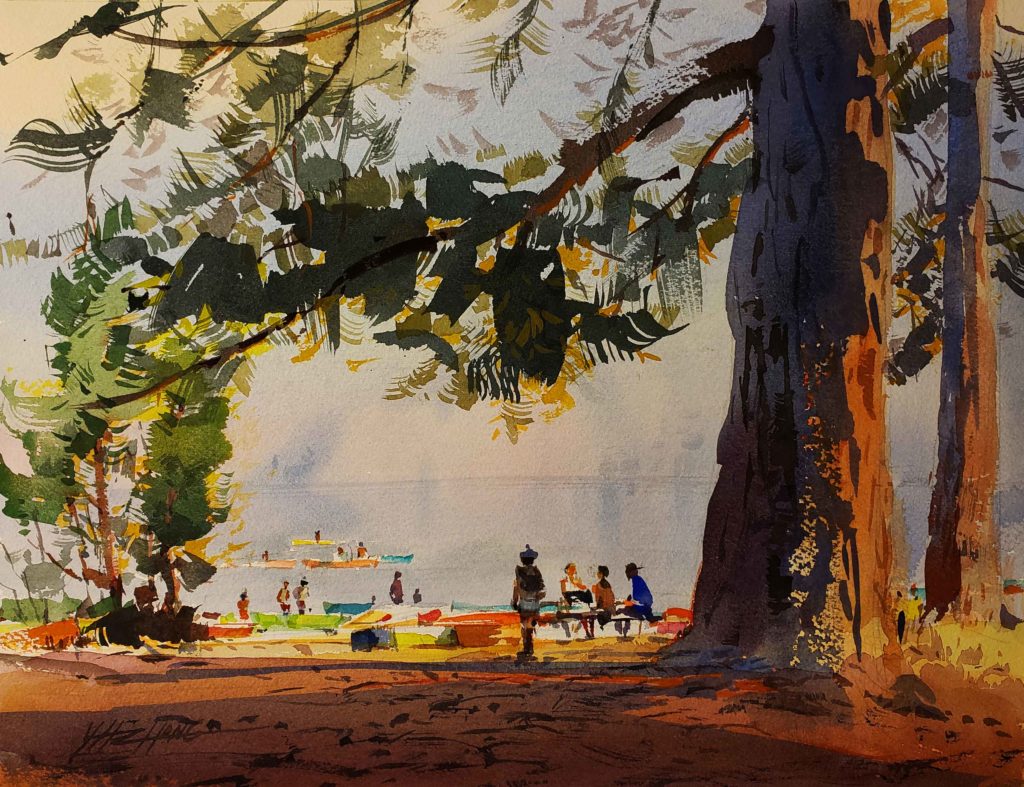The following is a watercolor painting demonstration from Yong Hong Zhong, featured in PleinAir Magazine (February/March 2019).
This is part of a series featuring a leader in the art community who has joined us on the faculty of Watercolor Live. The next one takes place January 24-26, 2024, with an Essential Techniques Day on January 23.
Yong Hong Zhong came upon this scene while he was participating in the Paint the Peninsula plein air event in Port Angeles, Washington. The competition was marked by thick, choking smoke from the California wildfires, but even in tragedy, an artist can find beauty. “Even though I felt guilty because the fires were so devastating, the sunsets at that time were just amazing,” Zhong says. Plus, the smoke simplified the visual elements and compressed the values.

***
Step 1:
Largely because it was a demonstration, Zhong spent little time on the graphite drawing. He quickly moved on to wetting the entire paper and washing in the background using the wet-into-wet method. He carefully brushed around some areas to retain the white of the paper in key spots.

***
Step 2:
The artist waited for the wash to dry completely, as the edges going forward needed to be sharp. His marks at this point were immediately bold, with crisp lines and angles. He did this using a rather large round brush — a Chinese calligraphy brush that allows him to flatten it for such effects.
“It’s similar to a round brush but allows you to get a more chiseled edge,” he says. This inexpensive brush also allows him to mix colors on the brush, so two colors go on the paper at the same time, in the same stroke. He was going for expressive strokes and colors here. “I wanted to make sure that I was capturing the experience I had in that specific moment — the engulfing smoke,” he says.

***
Step 3:
That bit of white near the center of the composition was then put to use. “This was a resort lake where you can rent kayaks, so I put in the table that the people renting kayaks used,” says Zhong. “The kayaks and the table provided scale, dark shadow, and intense color to create the focal point.” Some of the warm ground color was dragged up into the trunk of the primary tree to connect it with the earth.

***
Step 4:
Zhong’s bold strokes mark this stage, with the dark of the foliage created with strong, sure brushstrokes. A mistake at this stage would be devastating. “Watercolor is about taking a chance,” he says. “I understand the risks of watercolor. All of the work I have done prior to this stage hinges on how the darks work out in this step. I can ruin the painting, but I just have to trust my pencil drawing and not worry about matching the scene too much. I have to believe it will work out fine, or that I can get out another piece of paper and try again.”

***
Final Step:
Next, Zhong pushed back against the predominance of cool colors in the scene, taking advantage of the early morning sun to provide some warmth. “The warmth in the smoke enhanced the warmth of the morning light,” he says. “It was actually a choking smoke, and some of the artists were wearing masks. I focused on getting the feeling down, accurately depicting the atmosphere and the values. When I was finished, I felt that I was able to capture the mood and condition of the scene.”

Learn more about Yong Hong Zhong at yonghongzhong.com.
And browse more free articles here at OutdoorPainter.com




